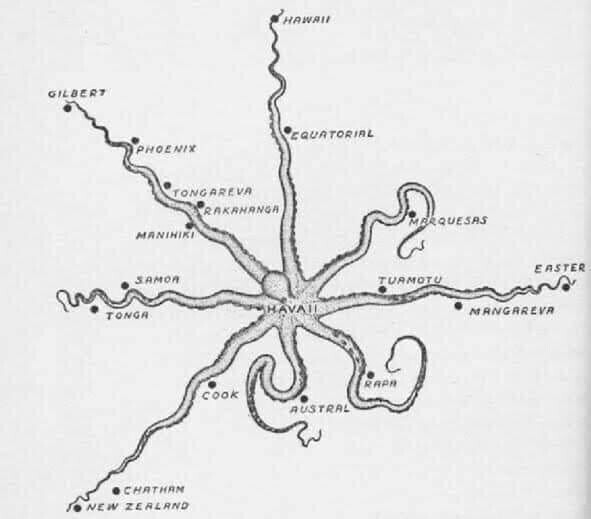Credit to KI Na
Jontelle Beech-Cullen
There is oral history in the Tahitian islands (Hawaiki)
Credit to KI Na 🥰🙏
Here is a map of sorts with the pacific islands being likened to a giant octopus.
The islands are on each arm and Ra’iatea (Rangiatea/Hawaiki)and Tahiti at the head as Ra’iatea (which was the most important and sacred place in Eastern Polynesia).
When you hear the story of Kupe finding NZ by chasing and conquering the giant Octopus Te Wheke-a-Muturangi (Muturangi’s Octopus) it makes sense that he wasn’t chasing an actual octopus but is a reference to the Tahitian navigator’s octopus “map” and conquering it is metaphor for surviving and discovering new Islands, the story goes that The octopus tried to take their double hulled waka (Matahourua) down, so it was probably a pretty tough journey
The legs are currents. Four currents in, four currents out. If you can navigate from leg to leg, its like a highway and will get you to where you're going much faster.
Each current is meant to go back to Hawaiki, possibly why we have the tradition of people believing that when Māori die they navigate back to Hawaiki from Te Rerenga Wairua (the leaping place of spirits) aka Cape Reinga. They believed and many still do today, that when we die our spirits go to cape Reinga and jump off into the water and return to Hawaiki across the sea.
The name Hawaiki comes from Savai’i in Samoa which was the birth place of modern Polynesians but the Hawaiki referred to here is now known to be Ra’iatea
There’s actually three Hawaiki, Hawaiki nui which we know is Ra’iatea who’s original name was Havai’i nui and Hawaiki Roa and Hawaiki Pamamao which makes sense to be Tahiti as Tahiti/Tawhiti and Pamamao mean the same thing (far away)
Link to article: There is oral history in the... - Jontelle Beech-Cullen | Facebook




